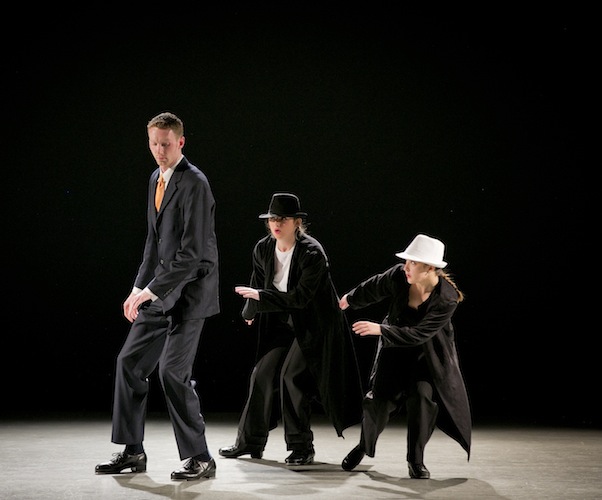Dance Review: “Gumshoes in Tap Shoes” — Sleuthing for a Voice
Gumshoes in Tap Shoes, a dance noir with ’60s big-band music from the likes of Henry Mancini, is an ambitious project.
Gumshoes in Tap Shoes. Conceived, choreographed, and directed by Ryan P. Casey. At the Dance Complex, Cambridge, MA, February 6 and 7.

A scene from “Gumshoes in Tap Shoes” Photo: Whitney Browne
By Marcia B. Siegel
Tap dance is essentially a solo form. Developed from street competitions, it’s suited to showing off the special skills and styles of individual dancers. Most tap shows I’ve seen use a revue format, with individual numbers loosely strung together and each number tied to a different piece of music. The extended story dance poses a different theatrical problem. It involves finding a throughline to connect the talents, creating a sense of ensemble among the performers, and devising a narrative scenario that “reads” to the audience.
That’s why Ryan Casey’s 45-minute Gumshoes in Tap Shoes, a dance noir with ’60s big-band music from the likes of Henry Mancini, is an ambitious project. Unusually tall and lanky, he’s made something of a name for himself as a solo dancer and a performer in other people’s choreography. I don’t know how many through-composed dances Casey has made, but this all-tap detective tale may be a first for him.
Casey plays a private eye without a clue. First we see two young women dressed ambiguously in open jackets over t-shirts and suspenders, with black pants, and derbies letting their long pony tails flow out. One carries an attaché case. We don’t get to see what’s in it. They might be commuters meeting on the early-morning platform. In silence, they sputter into a tap conversation, beginning with a remark or two. This is intriguing. Tap dancers often duplicate the phrases of accompanying music, but transposing speech rhythms into dancing is rare. We don’t know what this dialogue about, but the intensity escalates until the two characters are arguing. A girl in a skimpy red dress comes by and gets their attention. Dancing in unison to some ’60s big-band jazz, they chase after her as she exits.
We’ve caught a glimpse of Casey, trundling across the background; perhaps he’s trailing the two commuters, who turn out to be crooks. To a bluesy accompaniment, he gives a terse verbal account of the situation: “It was a cold day in January . . .” Shades of Guy Noir and Mickey Spillane. Apparently the girl in red has been abducted by the crooks, and Casey is determined to rescue her. “I could tell she needed my help.”
He locates the crooks and — here I lost the thread entirely — a trio dances back and forth in fast unison. The tension in their dancing tells you there’s something at stake, but what? Casey drops in at the nearest bar and after a discussion in the form of a tap challenge (“I didn’t want to trust her but she was all I had”), the barkeep advises him to look downtown. On his way, he dances a solo to a blues trumpet tune. Instead of tapping to every note in the music, Casey did variations on the rhythm.
The gumshoe hooks up with two girl assistants and they chase the crooks to Mancini’s Pink Panther music. Pointing their hands to mimic guns, they finally apprehend the crooks. I didn’t see the girl in red. Then they all took a bow in lineup, to “I’m Just Wild About Harry,” incorporating a bit of traditional shim sham shimmy in their routine.
There are obvious precedents for the show. Fred Astaire’s Girl Hunt Ballet from The Bandwagon (1953) and Gene Kelly’s Broadway Ballet in Singin’ in the Rain (1951) are both detective pieces, and both have Cyd Charisse as the mysterious femme fatale. Neither number has much tap in it, and neither one is any more explicit about who did what and why. I didn’t mind the gaps in the plot of Gumshoes, or the riffs borrowed from tap culture. Casey’s collaborators can dance, and I didn’t even mind females impersonating macho mobsters. But the cast, including Casey, seemed preoccupied with their steps, and ill-equipped to convey the double-edged wit of parody: playing convincing characters and at the same time acknowledging how tarnished these characters are.
For a would-be writer, painter, choreographer, it takes a while to find your voice. Lots of trial and error, poking around in the murk of your ideas, learning what works and what doesn’t. With luck you get good feedback from people you trust. As a fellow of the Integrated Artists Residency Program at the Dance Complex, Ryan P. Casey was mentored by executive director Peter DiMuro and choreographer Daniel McKusker. I don’t know if there’ll be more adventures for Casey’s private eye, but I look forward to them.
Internationally known writer, lecturer, and teacher Marcia B. Siegel covered dance for 16 years at the Boston Phoenix. She is a Contributing Editor for the Hudson Review. The fourth collection of Siegel’s reviews and essays, Mirrors and Scrims–The Life and Afterlife of Ballet, won the 2010 Selma Jeanne Cohen prize from the American Society for Aesthetics. Her other books include studies of Twyla Tharp, Doris Humphrey, and American choreography. From 1983-1996 Siegel was a member of the resident faculty of the Department of Performance Studies, Tisch School of the Arts, New York University
